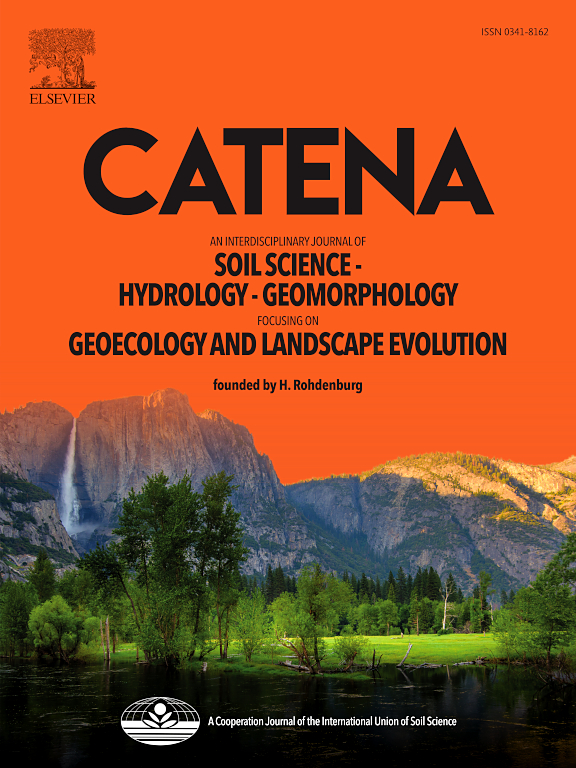中国西南地区泥石流链灾害定量评估的多情景模拟
IF 5.7
1区 农林科学
Q1 GEOSCIENCES, MULTIDISCIPLINARY
引用次数: 0
摘要
自2008年汶川特大地震以来,泥石流多次阻塞中国西南山区的河流,引发了众多洪水灾害和随后的连锁效应。这些地区的少数民族村庄主要位于高山峡谷地带,极易受到地震活动的影响,因此特别容易受到泥石流引发的洪水灾害链的影响。本研究以西南山区罗八街沟为例,阐明泥石流连锁灾害响应,强调此类研究的重要性。全面的实地调查为评估潜在危害的数值模拟提供了必要的数据,包括沉积物深度、水流密度和流速。模拟结果表明,只有百年一遇暴雨引发的泥石流才会导致罗八街沟河道堵塞,导致洪水淤塞导致河道水位明显上升。由此产生的洪水在堆积风机的淹没区内达到最大水深,对邻近工业区的影响最大。对百年一遇泥石流事件进行了定量风险评估,对潜在危害进行了评价。本研究通过详细的遥感影像分析、实地调查和数值模拟,详细分析了罗八街沟泥石流的运动过程和潜在危害,强调了采取有效的防治措施降低相关风险的必要性。由于黑水河流经汶川地震区,因此仍存在多处潜在的泥石流沟,潜在的泥石流对整个地震区构成不可忽视的威胁。本文提出的模型和理论可以有效地应用于类似情况下震区其他潜在泥石流的模拟和预警,从而促进其在洪水风险管理中的广泛应用。本文章由计算机程序翻译,如有差异,请以英文原文为准。
Multi-scenario simulations for quantitative assessment of debris flow chain hazards in southwestern China
Following the catastrophic Wenchuan earthquake in 2008, debris flows have repeatedly obstructed rivers across China’s southwestern mountainous regions, triggering numerous flood disasters and subsequent cascading effects. Ethnic minority villages in these areas are predominantly situated within alpine canyon zones highly susceptible to seismic activity, rendering them exceptionally vulnerable to flood disaster chains initiated by debris flows. This study focuses on Luobajie Gully in the southwest mountainous region as a case study to elucidate the chain hazard responses associated with debris flows and to highlight the critical importance of such research. Comprehensive field investigations provided essential data—including sediment depth, flow density, and velocity—for numerical simulations aimed at assessing potential hazards. Simulation results demonstrate that only debris flows triggered by a 100-year rainstorm event cause channel blockages in Luobajie Gully, leading to significant rises in river water levels due to dammed floodwaters. The resulting flooding reaches maximum water depths within the inundation zone of the accumulation fan, exerting the most substantial impact on adjacent industrial areas. A quantitative risk assessment of 100-year debris flow events was carried out to evaluate the potential hazards. This study analyzes in detail the movement process and potential hazards of the Luobajie Gully debris flow through detailed remote sensing image analysis, field investigation and numerical simulation, and emphasizes the necessity of taking effective preventive and control measures to reduce the associated risks. Since the Heishui River traverses the Wenchuan earthquake area, there are still several potential debris flow gullies, and potential debris flows may pose a non-negligible threat to the entire earthquake area. The model and theory presented in this paper can be effectively applied to the simulation and early warning of other potential debris flows in the earthquake area under similar circumstances, thus facilitating their wide application in flood risk management.
求助全文
通过发布文献求助,成功后即可免费获取论文全文。
去求助
来源期刊

Catena
环境科学-地球科学综合
CiteScore
10.50
自引率
9.70%
发文量
816
审稿时长
54 days
期刊介绍:
Catena publishes papers describing original field and laboratory investigations and reviews on geoecology and landscape evolution with emphasis on interdisciplinary aspects of soil science, hydrology and geomorphology. It aims to disseminate new knowledge and foster better understanding of the physical environment, of evolutionary sequences that have resulted in past and current landscapes, and of the natural processes that are likely to determine the fate of our terrestrial environment.
Papers within any one of the above topics are welcome provided they are of sufficiently wide interest and relevance.
 求助内容:
求助内容: 应助结果提醒方式:
应助结果提醒方式:


